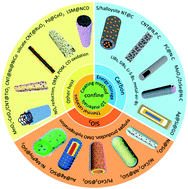1D confined materials synthesized via a coating method for thermal catalysis and energy storage applications
Abstract
Confined materials have been extensively studied to improve energy efficiency and mitigate environmental degradation due to their confinement effect. Compared with other methods of preparing confined materials, the coating method has the advantages of versatility and high efficiency. Although SiO2 NT confined materials have been widely used in thermal catalysis, few review articles have summarized this content. Additionally, preparation techniques for one-dimensional (1D) carbon confined materials using various carbon precursors and their energy storage applications have not been thoroughly discussed. Therefore, in this paper, we first introduce the synthesis examples and discuss critical factors influencing the successful coating of various host precursors upon the surface of guest materials. Then, their thermal catalysis and energy storage applications are analyzed and discussed together with the reasons which result in their excellent performance. Finally, potential research directions of designing 1D confined materials are formulated to motivate researchers and promote their energy and environmental applications.

- This article is part of the themed collection: Journal of Materials Chemistry A Recent Review Articles


 Please wait while we load your content...
Please wait while we load your content...